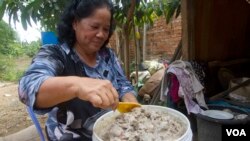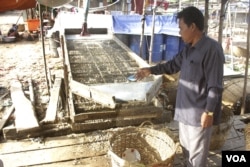In checkered shirts with long sleeves and pants, a Cambodian-Muslim, Sok Feut, has spent four to five days a month at a port in Phnom Penh’s Russei Keo district producing the traditional fermented fish paste prahok.
Feut, 48, whose day job is as a motor taxi driver, said that this year’s prahok fish is a bit better than last year.
“This year they can catch more fish [for prahok], but the amount of fish varies from day to day due to the level of the water,” he said.
Making prahok earns Feut from 150,000 riel to 200,000 riel ($37 to $50) per day.
Prahok fish are caught in the Tonle Sap Lake during the three months from December to February. The Ministry of Agriculture, Forestry and Fisheries announced that February 8 marks the end of the annual fishing season. During this season, thousands of trey riel, a type of small mud carp used to make prahok, swarm into Cambodia’s rivers.
Every year, travelers and farmers gather at the riverbanks some eight kilometers from Phnom Penh to buy and sell the fish. This year’s prahok fish sold at unusually high prices.
In late January, Feut told VOA that in the upcoming four or five days, more people will come to buy fish. “This year, more people come to buy fish, so fish prices are on the rise. The government made an announcement on television, so they came to buy fish,” he said.
Kjeung Seyha, 28, who owns a wholesale prahok fish business, said that there are more fish this year compared to last year, but the prices are higher; one kilogram of ready-made fish now sells for up to 3,500 riel (about 90 cents).
“In a day, we buy about a ton of fish for prahok. It also depends if the day has more fish, I will buy around one ton to 1.5 or 2 tons of fish,” she says. “They [fish sellers] also talk about last year’s drought, declining water levels and dam construction,” she said, referring to shortages of fish last year.
Prahok, a mix of crushed and salted fish left that is left to ferment, has become Cambodia’s signature dish and is served with nearly every meal. For farmers and Cambodians living along the rivers, prahok is as central to people’s diet as rice.
Last year’s prahok fish was not in ample supply due to the drought.
Wearing a headscarf, So Aisas, 37, says that she could not produce prahok last year, but this year she produced some 30 to 40 kilograms.
“Last year, the fish were so small I couldn’t make good prahok,” she said while sitting and preparing fish at her Phnom Penh home near the Tonle Sap river. She is also cautious about buying Prahok at the market, which she claims is treated with chemicals.
“Making prahok by myself is good and [I] can save some money. Buying prahok at the market is not good because it contains a lot of salt and powder. I am worried about my health,” she said.
High water levels are increasing this year's catch. The Ministry of Agriculture thinks that fish stocks in the Tonle Sap have been good this year due to improved water conditions and the effectiveness of crackdowns on illegal fishing.
The government has recently intensified the operations of a task force established to tackle illegal fishing, including by using a helicopter and speedboats to patrol the Tonle Sap Lake in an effort to curb illegal fishing.
Nao Thuok, director of the Ministry of Agriculture’s Fisheries Department, says that high water levels in addition to the recent crackdown on illegal fishing has drawn more prahok fish.
“The level of water is higher than last year…there are approximately 6,000 million cubic meters of water more than last year in the Tonle Sap Lake. It is good for fish breeding,” he said.
Regarding the high price of prahok, Thuok said that the middlemen play a role. However, he said the government has tried to help lower prices.
“When more people come [to buy fish for prahok], the price increases a bit, but we help intervene in decreasing the price,” he said.
The ministry expects hauls of the prahok fish to reach 13,000 tons in 2017, roughly 500 tons more than last year. The overall fish catch across the country could reach 800 000 tons including fish from aquaculture operations and rice-field fishing, according to Thuok.
Thuok is worried about the likelihood of further drought this year, but he hopes but he hopes it is not as bad as last year. “Climate change truly affects the livelihood of fisheries due to drought…leads to a lack of water and dead fish,” he said.
On the other hand, a number of people in Stung Treng province’s Sesan district see the controversial China-built Lower Sesan II hydropower dam, which is expected to open this year, having an ill effect on the region’s fisheries.
San Sorn, 55, who lives near the Sesan River in Phluk village, complains of shortage of fish due to the dam construction. “There are very tiny fish. I can only catch less than one kilogram of fish per day. Before I could catch a lot of fish,” said Sorn.
Another villager, Seth Sokha, 51, from Badeum village, said that now he rarely catches fish, which he blames the dam construction. “After they started building the dam, fish go down and the water is running low too,” he said.
However, Ha Kom 65, who is the biggest prahok seller in Stung Treng province, said that it is still a question for her if the dam really has had an adverse impact on water and fish.
“I don’t know yet whether the dam [Sesan] affect fish or not. Let see when the dam is opened,” she said.
Fishing season in the Mekong River differs from the Tonle Sap: one season is in February or March and another one in May, Kom says.
Thuok, the agriculture ministry official, said the dam in Stung Treng province may effect 20 percent of fish. “Normally it [a dam] has an impact, but we have to balance how large or small are the effects. We studied [the impact]. The important thing is to look for ways to mitigate it,” Thuok said.
In 2005, Prime Minister Hun Sen said the dam would have little negative impact. “There is no problem. No problem,” he said.
However, Om Savath, the executive director of the Fisheries Action Coalition, raised serious concerns over the impact on fisheries.
“It is a critical threat to Stung Treng province, since the two dams [the Sesan, and the Xayaburi in Laos] are in development,” he said.
In addition to local consumption, Cambodia is currently exporting Prahok to neighboring countries, mainly to Thailand. However, Thuok said that quality checks for international markets have not yet been formalized.
“We don’t have a proper refinery yet. We cannot export to other countries, since we don’t have proper quality checks yet.”










